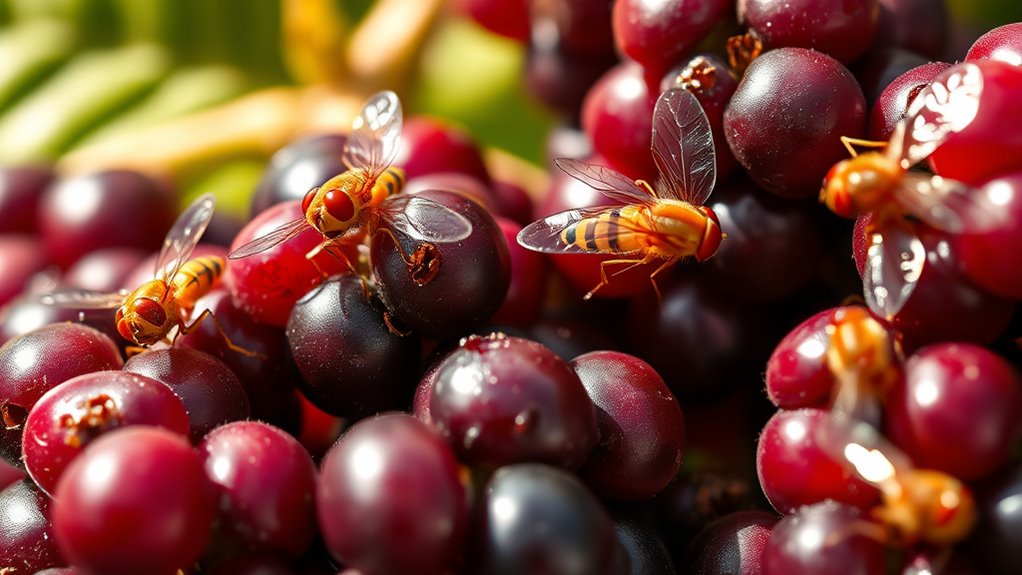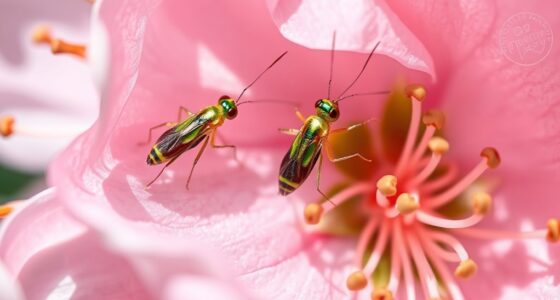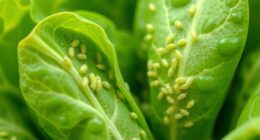Spotted wing drosophila (Drosophila suzukii) is a tiny fly that lays eggs inside ripening berries, causing internal damage and softening the fruit. To manage it, you should monitor for signs like punctures or soft spots, set baited traps, and implement organic controls such as insecticidal soap or netting. Proper sanitation and timely harvesting help prevent outbreaks. To effectively protect your crop, it’s important to understand all the best practices—keep going to learn more.
Key Takeaways
- Spotted wing drosophila can lay eggs inside ripening berries, causing internal damage and soft, rotting fruit.
- Use baited traps and regular inspections to detect early signs of infestation in berry crops.
- Employ organic control methods like insecticidal soaps, neem oil, and biological agents such as parasitic wasps.
- Maintain proper sanitation, harvest promptly, and cover plants with fine mesh to prevent fly access.
- Healthy, vigorous plants and consistent monitoring are essential for effective management of this pest.

If you’re growing berries this season, you should be aware that the spotted wing drosophila (Drosophila suzukii) is a pest to watch out for. This tiny fly can cause significant damage to your crop if left unchecked. Unlike other fruit flies, the spotted wing drosophila can lay eggs inside ripening berries, leading to larvae developing within the fruit. This results in soft, rotting berries that are unmarketable and can spread quickly across your entire harvest. Recognizing early signs of infestation and implementing effective pest management strategies are vital to protect your berries.
Effective pest management begins with monitoring. Use traps baited with attractants like yeast or wine to catch adult flies and keep track of their population levels. Regularly inspect your berries for any signs of damage, such as small punctures or soft spots. Once you notice the presence of these pests, it’s important to act swiftly to prevent an outbreak. To minimize damage, you can employ organic control methods. These include applying insecticidal soaps or neem oil, which are safe for the environment and non-toxic for beneficial insects, but must be used consistently and according to label instructions. Additionally, introducing natural predators, such as certain parasitic wasps, can help keep spotted wing drosophila populations in check over time.
Monitor regularly and use organic methods like insecticidal soaps and natural predators to control spotted wing drosophila.
Another key aspect of organic control involves cultural practices. Use clean, sanitized equipment to avoid spreading eggs or larvae from infested to healthy plants. Harvest your berries promptly once ripened to reduce the window of opportunity for the flies to lay eggs. Covering your plants with fine mesh netting can also be highly effective; it physically prevents the flies from accessing your berries, thereby reducing infestation risks. Removing and destroying any fallen or infested fruit helps eliminate breeding sites and interrupts the life cycle of the pest.
Maintaining a healthy, vigorous berry crop can also contribute to resistance against spotted wing drosophila. Proper watering, fertilization, and pruning promote strong plants that can better withstand pest pressure. Remember, organic control requires patience and consistency. Combining multiple methods—monitoring, biological controls, cultural practices, and physical barriers—gives you the best chance of managing this pest naturally. Staying vigilant and proactive will help you protect your berries without relying on chemical pesticides, ensuring a healthy, organic harvest.
Frequently Asked Questions
How Can I Distinguish SWD Damage From Other Pests?
You can distinguish SWD damage by looking for small, sunken oviposition scars on the berry surface, which are unique to this pest. The damage often appears as shriveled, soft, or overripe spots, along with tiny punctures where eggs were laid. Unlike other pests, SWD-inflicted berries may show rapid softening and collapse, making visual damage and oviposition scars key identifiers to spot early infestations.
Are There Organic Methods to Control SWD in Berries?
Yes, you can use organic control methods for SWD in berries. Effective pest management includes applying insecticidal soaps or neem oil, which target the pests without harming beneficial insects. You should also cover your berries with fine mesh screens to prevent adult flies from laying eggs. Regularly monitoring and removing infested fruit helps break the pest cycle. Combining these strategies provides an eco-friendly approach to managing SWD organically.
What Is the Lifecycle Duration of SWD?
You should know that the lifecycle timing of spotted wing drosophila (SWD) generally spans about 8 to 10 days, depending on temperature. Pest identification early on is essential for effective control. As temperatures rise, the lifecycle speeds up, leading to multiple generations in a season. Monitoring for adult flies and larval presence helps you time interventions better, reducing damage to your berries.
Can SWD Infestations Occur in Greenhouse Berries?
Yes, SWD infestations can occur in greenhouse berries. You need to stay vigilant with greenhouse infestations, as the flies can quickly establish and damage your crop. Effective berry crop management involves regular monitoring, using traps, and applying targeted treatments when needed. Keep the greenhouse environment clean and avoid overripe fruit, which attracts SWD. Proactive measures guarantee your berries remain healthy and minimize infestation risks.
What Are the Economic Impacts of SWD on Berry Crops?
Imagine losing 30% of your berry harvest to SWD infestation, causing significant economic losses. SWD can decrease fruit quality and yield, forcing you to reduce prices or discard affected crops. This market impact can lead to declining profits and increased production costs. Such infestations threaten your farm’s profitability, emphasizing how vital integrated pest management is to protect your income and sustain your berry business.
Conclusion
Think of the spotted wing drosophila as a tiny thief sneaking into your berry garden. By staying vigilant and practicing good management, you become the vigilant guardian, blocking the thief’s entry. Remember, each berry you protect is like a treasure chest you’re safeguarding from unwelcome intruders. Stay alert, act promptly, and turn your garden into a fortress — ensuring your berries remain delicious and yours to enjoy, not stolen by this tiny bandit.









